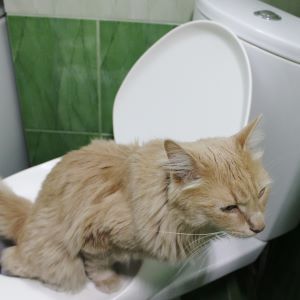Introducing your new kitten to other pets
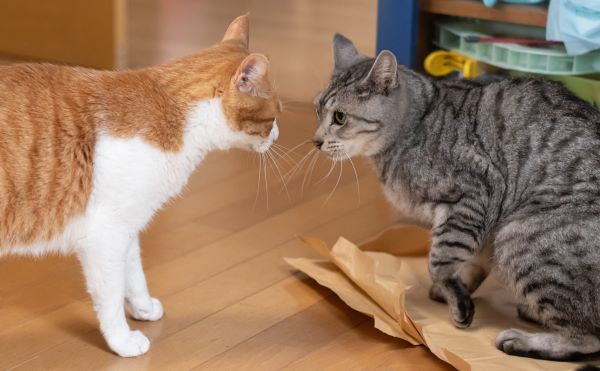
Meeting other pets can be stressful, both for the new arrival and the resident animal. The key to a successful outcome for both animals is to introduce your kitten to your other pets slowly and gently.
Start off with separate areas
If possible, divide up your home so that old and new pets are kept as far apart as possible for the first few weeks after bringing home a new kitten. Have the new cat in one area of the house and the existing pet in the other, with a “no man’s land” or neutral territory, such as a corridor or staircase, between them, so that they cannot encounter each other (not even under or through a door) unless supervised.
 If the existing pet is happiest upstairs, keep her there and have the newcomer in a downstairs room, for example. You don’t want your existing pet to feel ‘displaced’ by the new kitten. Don’t take any of your existing pet’s possessions to give to the new pet, or have them share resources. If time permits, get your existing pet used to this change a few weeks in advance of the new arrival by gradually moving her toys, bowls, bedding and other possessions into her designated area.
If the existing pet is happiest upstairs, keep her there and have the newcomer in a downstairs room, for example. You don’t want your existing pet to feel ‘displaced’ by the new kitten. Don’t take any of your existing pet’s possessions to give to the new pet, or have them share resources. If time permits, get your existing pet used to this change a few weeks in advance of the new arrival by gradually moving her toys, bowls, bedding and other possessions into her designated area.
Once the new arrival appears, try to keep things as ‘normal’ as possible for your existing pet, including the amount of time you spend with her. Increasing your time with her is even better; it will build positive associations with her new situation and the new arrival.
For the newcomer, it’s important to have his own area where he can feel safe and secure – a spare bedroom, the laundry room, or other area that isn’t usually frequented by the existing pet. Remember that this is a temporarly situation with the long term goal being equal access to all areas by all pets. But this will take time and patience. Only once the new kitten has adapted to his own area and feels comfortable in it, is it time to gradually expand his horizons to other parts of the home and to the rest of the family, including other pets.
Introductions are key
Slow, appropriate and well-timed introductions are critical for achieving a positive outcome – ideally, a peaceful household containing happy pets who enjoy each other’s company, or perhaps more realistically, pets that tolerate each other calmly.
Introducing a new kitten to an existing cat
Many cats prefer being the only cat in the home. However, if there is no competition for food, litter trays or sleeping places in the house, cats can learn to tolerate each other and can sometimes become good friends.
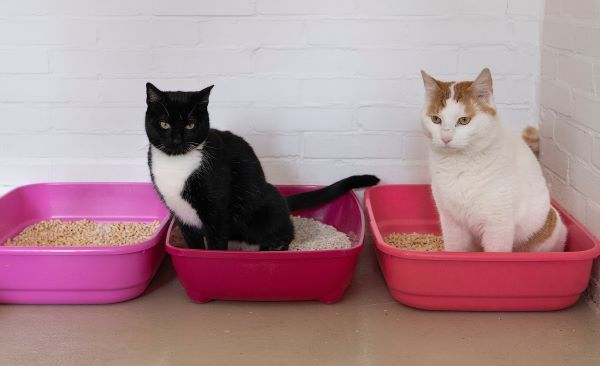
It can take anything from a day to many weeks for cats to tolerate each other so persevere and don’t give up.
Introducing a new kitten to an existing dog
Good relationships between cats and dogs can be achieved, especially if their early experiences are positive. Careful and patient introductions are key in achieving this. Take care to avoid even a single bad experience, such as them seeing each other when excited or fearful, which may lead to the dog barking or the cat hissing, which can then set them up for future negative interactions.
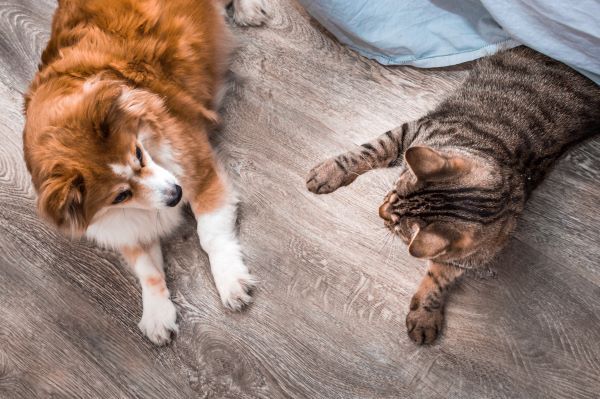
Be aware that it’s not just the new kitten or cat that may be feeling insecure or threatened. In fact, existing dogs, particularly those that have a strong territorial or chasing drive, may have more of a problem adapting than the new arrival. Try to keep things as normal as possible for the resident cat or dog and avoid spending too much time with the new arrival to the exclusion of the existing pet. If you think that your dog might be aggressive towards the newcomer, or are unsure how he will react, plan their introduction with safety in mind.
Step-by-step introductions
Step 1: Swapping scents
The first step in the introductions should be swapping each other’s scent for a few days, rather than any face-to-face encounters. Don’t wash your hands between touching them to allow them to smell each other on you. When they are relaxed with this, take an item of bedding from the new kitten and place it in a neutral spot, away from their bed, bowls and litter tray in your other pet’s area, and vice versa.
Step 2: Exploring the neutral area
When they are completely comfortable with the above, allow each pet separately into the “neutral territory” for short periods, so that their scents become even more familiar, and they can investigate where the other has been. Be aware that this process may be easier for dogs than for cats, and that it may take a new kitten longer to feel comfortable in a new space, particularly one with a dog’s scent in it.
Step 3: Limited visual contact
If you have a gap under the door of the new kitten’s room, let them smell each other through it. Only do this when both pets are calm. Have one family member inside the kitten’s room to observe her reaction and ensure she doesn’t get too stressed, and another outside the door to monitor the other pet and ensure he doesn’t react negatively. If the existing pet is a dog, have him on a lead in case you need to get him away quickly.
Place your new cat in her carrier and take it to a neutral place to let her see your other pet to her without letting her out. This way she feels secure and your other pet will not be upset. Again, keep a dog leashed and have another family member with you so that you can separate them quickly and easily if there are any signs of stress by either pet. After doing this a few times you should be able to sense when they are relaxed around each other.
Step 4: Face to face
Once both old and new pets seem comfortable in each other’s presence, you can open the cat carrier and let them explore each other briefly, again with two familiar humans present so that both pets can be supervised. Another option is to set up a baby gate in a neutral area, allowing them to see each other and sniff each other with the safety of a barrier between them.
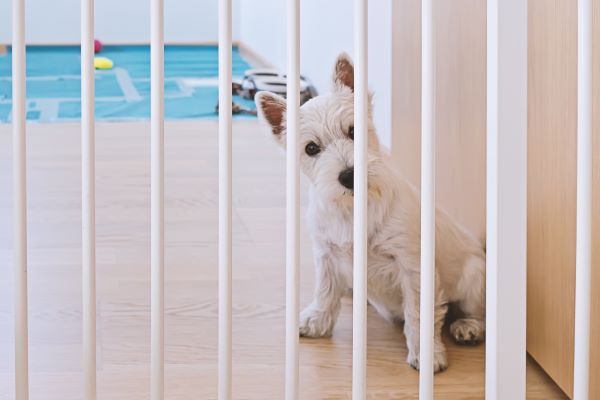
If the resident pet is a dog, have him on a leash or harness in case a hasty retreat is necessary, and ask him to sit and stay if either he or the kitten becomes agitated during the introduction. Resident cats may not respond to voice commands, but they can also be placed on a harness for quick avoidance of aggressive behaviour.
If both pets remain calm and relaxed, gradually increase the time they spend together, ensuring constant supervision. Praise both pets consistently for their calm behaviour. Look out for any signs of emotional arousal in either pet, such as vocalisation or changes in body language. It’s best practice to end each session while both pets are still visibly relaxed, so as to avoid resorting to “crisis management”, which may have a negative impact on future relations.
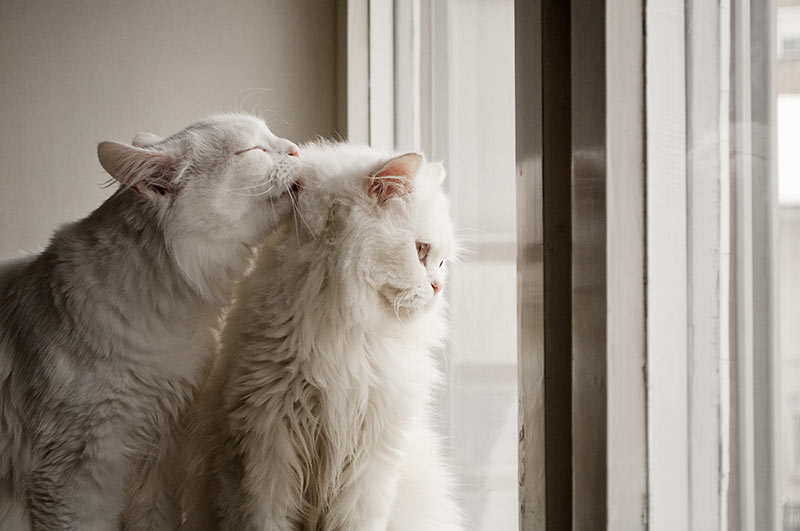
Advice for the future
Don’t expect your pets to get on well together right away. Some pets need time to adjust, and this process can take anywhere from a couple of days to weeks or even months. Continue to supervise their interactions for a few months after introduction.
Do expect some hissing or growling – this is very normal behaviour. Make sure that your new kitten continues to have a safe place to retreat to if she becomes anxious or overwhelmed.

When both are sharing the house equally, if the existing pet is a cat, be sure to minimize competition for resources such as food, water, beds and litter trays by providing ample of these (a good rule of thumb is one for each cat, plus one spare). Keep their feeding and sleeping in separate locations, at least for a while.
Also, continue to deter competition for your attention and affection by giving these equally to each animal. The desirable outcome is a peaceful household in which pets have formed friendly relationships, or at least accept each other’s presences calmly.
Summary
 Taking your time to introduce your new kitten and your existing pet to each other will increase the likelihood of them getting on well down the line. Cats are often stressed by a change of environment, and if you already have a pet in the home, keep in mind that it can take a few weeks or more for your new kitten and your other cat or your dog to feel relaxed and comfortable in each other’s presence. Patience and perseverence are the key to a happy outcome!
Taking your time to introduce your new kitten and your existing pet to each other will increase the likelihood of them getting on well down the line. Cats are often stressed by a change of environment, and if you already have a pet in the home, keep in mind that it can take a few weeks or more for your new kitten and your other cat or your dog to feel relaxed and comfortable in each other’s presence. Patience and perseverence are the key to a happy outcome!
Bow Wow Meow Pet Insurance can help protect you and your kitten should an unexpected trip to the vet occur.
-
Find out more about our cat insurance options
-
Get an instant online pet insurance quote







